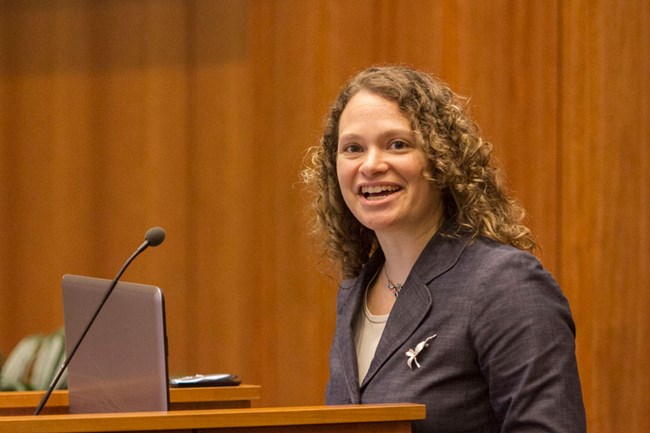
Chapter 24
Dr. Sara Schwebel, Professor of English, University of South Carolina, and editor of Island of the Blue Dolphins: The Complete Reader’s Edition (University of California Press, 2016), discusses Karana’s decision to never kill another animal to make clothing or tools.
The summer after Tutok leaves, Karana befriends Won-a-nee and realizes that animals have now taken the place of humans in her life: they are her family and friends. She decides to never kill another animal to make clothing or tools (although she will continue to eat fish and shellfish, a central part of her diet). Later in the story, when the white men arrive to hunt otter (chapter 29), Karana will pretend she does not know where the animals live.
The historical Lone Woman did not behave this way: animal furs were essential for warm clothing, and bones and sinew were necessary for fashioning tools and weapons. When the otter hunting party led by George Nidever first saw the Lone Woman on San Nicolas Island, she was wearing a dress made of cormorant skins and belted at the waist with a rope made of sinew. She carried seal meat with her when she accompanied the otter hunters to their camp, where she lived with the men for a number of weeks. In her presence, the white American, Chumash, and Gabrielino (Tongva) hunters killed and skinned otter for the maritime fur trade.
Animals were nonetheless important companions for the historical Lone Woman. George Nidever and Carl Dittman describe in their memoirs the way that dogs responded to the Lone Woman’s commands; they were clearly well-trained pets.
The difference between the ways the historical Lone Woman and the fictional Karana interacted with animals is important to Island of the Blue Dolphins’ enduring popularity. Karana’s pescatarian (fish and shellfish) diet and vow never to kill mammals or birds spoke to readers who were becoming increasingly concerned, after World War II, about the way human behaviors were affecting the natural world.
Scott O’Dell was an early environmentalist. He described a central motivation for writing Island of the Blue Dolphins as his anger toward the hunters who killed animals in the mountains near his home in Julian, California. He hoped that readers of Island of the Blue Dolphins would come to love the animals that lived on Karana’s island and because of that, they would want to protect all animals against human violence.
Rachel Carson, a marine biologist, also believed that people could be stirred to anger and action through books. In 1962, two years after Island of the Blue Dolphins appeared in print, she published Silent Spring to popular and critical acclaim.
Silent Spring’s topic was the dangerous effect of synthetic pesticides, but more broadly, the book warned readers that human actions affected the natural world, and that this had serious consequences for humans themselves. Today, historians point to Rachel Carson’s book as the beginning of the modern environmental movement in the United States. It not only influenced government policy but also motivated individual readers to take action. It was a call to arms.
Silent Spring was published by Houghton Mifflin, the same publisher that produced Island of the Blue Dolphins. Before O’Dell’s novel appeared in print, O’Dell’s editor asked Rachel Carson for her opinion of the book. She wrote: “It held me spellbound from the first word. The limpid beauty of its prose, the timeless and elemental quality of its theme, combine to make a book that would be memorable in any year. … It is fine to have such a book for young readers, but I hope you’ll make clear its appeal to adults also” (12 Feb. 1960, Rachel Carson to Austin Olney, MSAM 2105 [194], Houghton Library, Harvard University).
Rachel Carson’s praise for O’Dell later appeared in print advertising for Island of the Blue Dolphins. Librarians who admired the novel’s message about caring for animals—an easy way for children to relate to environmental issues—recommended the book to young people. Elementary school teachers used the book in their classrooms for both reading and science lessons. They still do.
-
Listen to chapter 24 entry
Learn about Karana’s decision to never kill another animal.
Last updated: April 26, 2025
